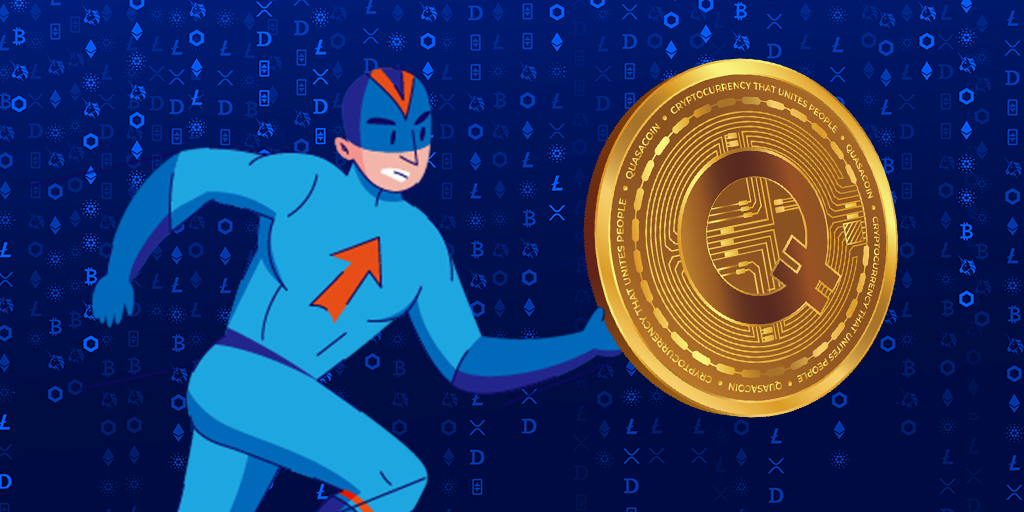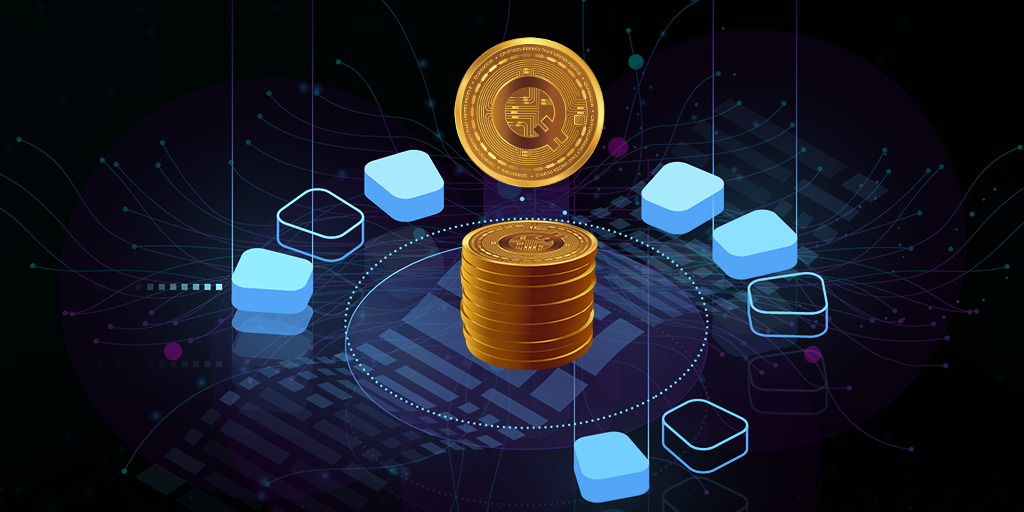The Crypto Future of Work
In the future, you'll work with people you don't know, on projects you can't control, based on contracts you didn't sign, financed by people who aren’t actual investors. You'll pay to work and get paid to do things that were previously considered leisure.
 Things are done differently in the world of blockchains and decentralized finance. And they offer a vision of what all careers and corporations could look like one day.
Things are done differently in the world of blockchains and decentralized finance. And they offer a vision of what all careers and corporations could look like one day.
You don't need to own $BTC, $ETH, $UNI, $QUA, or $DOT to learn from these "entities." And whether you're a crypto investor or not, new ways of working and incorporating will affect your career, business, and investment portfolio.
To paraphrase Trotsky, you may not be interested in crypto, but crypto is interested in you.
Below is a superficial survey of the characteristics and consequences of some of the most exciting crypto projects.
No Offices
Some of the most important projects in the crypto space are developed by remote and partly remote teams. This includes platforms, tools, and protocols such as Uniswap, MetaMask, Maker, Polkadot, Solana, QUASA and Ethereum used by tens of millions of people and process billions in transactions each day.
 These projects are wholly or partly open-source, meaning their source code can be reviewed and edited by anyone. Some are structured as foundations that do not own the source code but are tasked with maintaining it and nurturing a community of paid and volunteer contributors.
These projects are wholly or partly open-source, meaning their source code can be reviewed and edited by anyone. Some are structured as foundations that do not own the source code but are tasked with maintaining it and nurturing a community of paid and volunteer contributors.
Since the work is done remotely and is coordinated by algorithms, a lot of it also tends to be done asynchronously. People complete their tasks at different times instead of all working together during the same hours.
Remote work comes naturally to many crypto teams because the products and protocols they develop are decentralized. The original Bitcoin white paper popularized the idea of a payment system that operates without a central trusted authority. In such a system, multiple computers (nodes) in various locations participate in the processing and validating of information.
No Corporations
The Ethereum white paper built on the idea of decentralization and suggested it could apply to whole organizations, not just to a system that processes payments. In 2013, Vitalik Buterin introduced the concept of Decentralized Autonomous Organizations (DAOs), an alternative to modern corporations that automates a lot of the work done by corporate boards and senior executives.
 In such DAOs, decisions are made by algorithms and human stakeholders.
In such DAOs, decisions are made by algorithms and human stakeholders.
The DAO is structured in a way that incentivizes all participants to work towards the goal it was founded to serve. Human stakeholders gain voting rights by buying tokens or by earning them in exchange for contributing their time and resources to the organization.
In addition to fully automated organizations, Digital Organizations (DOs) are not as rigidly structured but still use tokens and some code to coordinate the efforts of human contributors.
In many crypto projects, stakeholders — customers, partners, volunteers, employees — essentially own the project and have the right to enjoy the cash flow it generates and vote on governance changes.
This type of community ownership is akin to owning shares in a corporation, but with some key differences. Most notably, the customers of many crypto projects must own a token in order to access any products and services.
In other words, they cannot be customers unless they are also “shareholders.” Their rights and responsibilities are programmed into the organization itself rather than contingent on the goodwill of the executive team. This customer-shareholder combination also means that users have a financial incentive to support the project’s growth and well-being.
No Colleagues
While users play a key role in governing and developing many crypto projects, they can do so without exposing their identity. Every user is represented by a public key.
 This key is like an avatar you can use to represent yourself when interacting with others or accessing goods and services. The key serves as a pseudonym that allows you to maintain a stable identity, build reputation, and have unique privileges without exposing your real name or sharing your personal information each time you interact.
This key is like an avatar you can use to represent yourself when interacting with others or accessing goods and services. The key serves as a pseudonym that allows you to maintain a stable identity, build reputation, and have unique privileges without exposing your real name or sharing your personal information each time you interact.
Pseudonymity makes it possible for people to work together on a project or even run an organization without knowing each other. It allows people to get to know each other without exposing their offline/biological/ governed-issued identity.
Many blockchain projects and services are also permissionless, meaning that anyone can use them and contribute to them. This has been true for open source projects such as Linux, Android, and WordPress. Still, the addition of crypto’s unique incentives and governance structures takes permissionless development to a new level.
No Freeriders
In traditional open-source projects, many contributors are unpaid volunteers or paid employees of companies that use the project’s code and are willing to contribute their (human) resources.
In either case, the individual human contributors are not compensated directly for their contribution. Under this arrangement, nobody is paid fairly. Those who work for free get nothing. Those who get paid by the hour are often the main contributors, but their compensation is not commensurate with the amount of value they create.
 We can observe the same dynamic in most industries and professions. Companies employ multiple people.
We can observe the same dynamic in most industries and professions. Companies employ multiple people.
These people are compensated based on their seniority, credentials, and level of responsibility. Each employee’s contribution varies widely.
But the difference in compensation is restricted to a relatively narrow range — the best employee makes 20-50% of the average one, even if her contribution is 700% more valuable).
Blockchains offer an alternative model. For some tasks, they make it possible to compensate each person according to their specific economic contribution.
Multiple people who contributed code, content, or ideas to a project or even to a meeting can get paid based on the relative importance of their contribution. This can be done automatically and on an ongoing basis. Suppose the project/product generates revenue over time.
In that case, all original contributors can continue to receive “dividends” from it in the same way that a recording artist receives royalties each time a song is sampled or streamed.
No Investors
This section might be too complex if you don’t have any finance background. Don’t get hung up on the details; you only need to understand the basic principles. If it’s too much, you can skip ahead to the next section.
 We’ve seen above that the traditional boundaries between customers and shareholders are blurred when it comes to crypto projects. Customers often have to own tokens to use a service or product, and these tokens give them economic and legal rights.
We’ve seen above that the traditional boundaries between customers and shareholders are blurred when it comes to crypto projects. Customers often have to own tokens to use a service or product, and these tokens give them economic and legal rights.
Tokens play a vital role in the crypto world.
They can serve as “tickets” to access events, as “coupons” to receive goods and services, as “shares” to receive rights to cash flow from a business, and as “votes” that govern an organization or project.
Since every app and project have their own token, users quickly find themselves with dozens of different tokens (just like users of non-blockchain apps have multiple user names for various services such as Facebook, Uber, Airbnb, etc.). If they try to exchange one of their tokens for another, or for cash, they will likely encounter a problem.
The market for most tokens is not very liquid in the same way that the market for most small fiat currencies is not very liquid. You can walk into any bank and exchange US Dollars for Euros, but you’re less likely to be able to find a bank that will take Vietnamese.
 There are only 180 or so fiat currencies globally, but there are tens of thousands of tokens for crypto projects, hundreds of which are used by a significant number of people.
There are only 180 or so fiat currencies globally, but there are tens of thousands of tokens for crypto projects, hundreds of which are used by a significant number of people.
If the market for these tokens is not liquid, users can be stuck with “shares” that can never be exchanged.
The inherent lack of liquidity is addressed by Liquidity Pools, one of the most interesting mechanisms of blockchain-based finance (usually referred to as Decentralized Finance or DeFi). Liquidity Pool incentivizes people to provide liquidity to the market for a specific pair of tokens or currencies.
In traditional finance, the bank pays you interest to keep your cash in the bank. This way, the bank always has enough money to give out to someone looking to withdraw some money. When the bank is low on deposits, it increases the interest rate to encourage more people to store their cash in the bank. (in practice, even traditional banks no longer work like this, but that’s the basic idea behind savings accounts)
Liquidity Pools follow the same logic. They incentivize owners of different tokens to “store” these tokens in the “pool” to ensure that any possible exchange could be executed immediately.
 But such pools are not operated by banks; they are operated by pre-programmed protocols that automatically set the yield (interest rate) for each pair of tokens.
But such pools are not operated by banks; they are operated by pre-programmed protocols that automatically set the yield (interest rate) for each pair of tokens.
Liquidity pools act as market makers to ensure there’s always a market for whatever token someone is trying to buy or sell.
Since this process is automatic, such pools and the protocols that govern them are also called Automated Market Makers (AMMs).
AMMs ensure that smaller projects can get funded and that the overall token economy continutes to function. Beyond their financial role, they also offer a mechanism that can be used to increase the liquidity of talent itself. More on this, in the next section.
No (Solid) Teams
The ability of individual contributors to step in and out of projects they like and get compensated for whatever they leave behind opens up new possibilities.
Such teams can work together for a day, a month, or a year, but they are liquid by definition: No one hired them, and no one forces them to work together. Each team member can work in parallel on other projects, on their own, or as part of a different.
 This type of arrangement opens up the possibility of Talent Liquidity Pools (TLPs), groups of expert individuals that can provide projects and organizations with guaranteed expertise to address specialized tasks on-demand at any given moment.
This type of arrangement opens up the possibility of Talent Liquidity Pools (TLPs), groups of expert individuals that can provide projects and organizations with guaranteed expertise to address specialized tasks on-demand at any given moment.
Think of TLPs as “Uber for cognitive tasks.” A company can hire a single engineer $500,000 to spend 200 days at the office and handle occasional questions about an exotic implementation of a database for a customer with particular needs.
Or, the company can simply tap into a Talent Liquidity Pool with the world’s top twenty engineers with that specific expertise.
Access to the pool will cost the company only $200,000 per year and be at its disposal 24/7/365 (pools don’t take sick days). But since many companies will rely on the same Talent Liquidity Pool, the twenty participating engineers will make more than the $500,000 they would have made as employees — or enjoy the non-cash benefit of working more flexible hours. TLPs won’t be able to address every task, but they can address many.
The Talent Liquidity Pool is not simply a group of people that formed a cartel or guild to set the prices for certain services. On the blockchain, the fees they charge can be set automatically based on actual and expected demand. The potential fees can rise to attract more experts to the pool when need. In that sense, TLP’s can operate as Automated Market Makers.
Companies like Upwork and TopTal and even Uber itself already offer some level of on-demand talent.
But these companies are centralized, not owned or governed by their participants, and do not offer the type of granular, automated compensation that blockchains enable.
No Work
Finally, crypto’s most interesting perspective on the future of work is that it won’t involve any actual work. At least some of the time, people will be able to earn money by doing things previously considered leisure and spending money on things previously considered work.
Let’s look at a few examples. On Axie Infinity, people earn money by playing a computer game that generates tokens that can be converted into actual cash.
The game is increasingly popular because players get paid to play; players get paid because investors buy their tokens; investors buy the tokens because they think their value will increase due to the game’s popularity. People on Axie play to work.
People will also be able to earn a living simply by being nice to each other. As mentioned above, tokens create a royalty-like system where every person can be compensated for tiny and specific contributions and actions.
This, in turn, enables a more granular and complex division of labor than the one we currently have. It is now economically viable for “vendors” to sell hyper-specialized services and to allow customers to mix and match these services as they please.
 The “Sharing Economy” already turned many acts of kindness into sellable commodities: giving someone a ride, letting someone sleep on your couch, lending a tool to a neighbor.
The “Sharing Economy” already turned many acts of kindness into sellable commodities: giving someone a ride, letting someone sleep on your couch, lending a tool to a neighbor.
These were previously handled by local communities and are now facilitated by commercial enterprises. More radical examples of this dynamic are visible in some corners of the internet, where people pay other people to say their names, smile at them, and give them attention.
Blockchain technology puts this dynamic on steroids, making it possible to compensate and incentivize people to behave in ways that make other people happy.
“Imagine paying a monthly fee to ensure everyone you see says hello to you. Or letting your neighbor earn a fixed amount every time he keeps the volume down and lets you sleep well at night (your sleep tracker will automatically trigger a smart contract that compensates the neighbor each morning; there’s no need to actually speak to him or say thank you). I’ll leave it to your imagination to come up with other possibilities.” I call this the token society, a society where explicit financial incentives govern many/most social interactions.
 The token society assumes that most people will not be required to work to produce food, shelter, and other necessities.
The token society assumes that most people will not be required to work to produce food, shelter, and other necessities.
In such an economy, most human work will focus on serving and entertaining other humans. In such an environment of abundance, people will not only get paid to play and be nice. Some of them will also pay to work.
This is already happening. As I mentioned above, people buy tokens to contribute code and participate in the governance of different crypto projects. They pay to be able to work for free. Some of them hope that their free work will contribute to the project’s success and, in turn, make their tokens more valuable.
 But humans are not driven only by financial incentives. They contribute to a project because they want to be part of the project.
But humans are not driven only by financial incentives. They contribute to a project because they want to be part of the project.
They want to be part of something. This, too, is already visible in many companies and industries. Employees are expected to work more or earn less in exchange for feeling like they’re part of something bigger than themselves.
But crypto makes this implicit bargain explicit.
We’re headed to a world where 🛒 work is a consumer activity.
People do it to signal their values and find meaning.
Some people have always found meaning in their work, but historically, work had a practical purpose, and “meaning” was a bonus: Farmers produced wheat and could feel proud that they are feeding the world; Ford employees produced cars and could feel proud they are making America great.
But now, the “meaning” itself is becoming the primary purpose of work. What is being produced is often useless or frivolous. The primary value created by the work is to keep the worker happy, engaged, and entertained.
This brings us to a final aspect I’d like to mention today. The future of work will not just be community-like; it will often be cult-like. People will follow charismatic leaders into projects and initiatives that give their lives meaning.
There’s so much more to explore, but I’ll stop here for now. I’d love to hear your thoughts. What else can crypto teach us about the future of work? Which other examples can I look at to illustrate the ideas above?
Thank you for reading.






